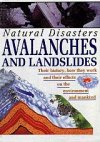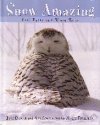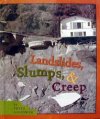Snowflakes and Avalanches Additional Information
Information about avalanches is available at nsidc.org/snow/avalanche/ (National Snow and Ice Data Center) and en.wikipedia.org/wiki/Avalanche(Wikipedia).
You can learn more about avalanche research at www.montana.edu/wwwvr/activities/activities03/avalanche.html (Montana State University) and www.avalanche.org/~nac/NAC/techPages/spatVar.html (Forest Service National Avalanche Center).
Jeff Dozier and his research are featured at www.icess.ucsb.edu/hydro/hydro.html (University of California, Santa Barbara).
The National Avalanche Center Web site is available at www.fsavalanche.org/(U.S. Forest Service).
Books recommended by SearchIt!Science:
 |
Avalanches and Landslides— Jane Walker
Published by Franklin Watts/Scholastic, 1992.
In 1962, an avalanche in Peru destroyed eight villages and killed 3,500 people in just 7 minutes. Hundreds of avalanches, made of huge masses of snow, and landslides, made of rocks and mud, crash down from mountains every year. Most of them happen in remote areas, so they don’t affect people. Packed with color photographs, cutaway diagrams, and maps, this book features descriptions of the different types of avalanches and landslides. The book provides examples of the devastation caused by these natural disasters. It also discusses what people can do to predict and prevent avalanches. |
 |
Snow Amazing: Cool Facts and Warm Tales— Jane Drake, Ann Love
Published by Tundra Books, 2004.
If you want to know anything and everything about snow, turn to this playfully illustrated book. Its short chapters cover dozens of snowy topics: how snow crystals develop, spring thaws, how filmmakers film snow, snow prints, avalanches, snowbirds, and more. Along with weather information, stories of snowy expeditions, and information about snow-dwelling plants and animals, the book offers wintry folktales from around the world. |
 |
Landslides, Slumps, & Creep— Peter H. Goodwin
Published by Franklin Watts/Scholastic, 1997.
Avalanches, landslides, slumps, and creeps are all examples of a natural event known as mass wasting. Mass wasting results from the downward movement of rocks or snow. It can happen quickly, due to a sudden thunderstorm. In other cases, it takes place over many years. Whatever the pace, mass wasting can cause extensive damage to homes, roads, and the environment. This book describes how scientists have studied this natural phenomenon and how people have attempted to prevent it. A chapter on historic landslides details the events of some of the most tragic and spectacular cases of mass wasting in recent times. |
Power Words
avalanche The fall or slide of a large mass of snow or rock down the side of a mountain.
snow Water that falls to the Earth as crystals of ice, called snowflakes. The crystals form in a cloud when water vapor freezes suddenly, without first condensing into a raindrop. Snow is a form of precipitation.
 |
Copyright © 2002, 2003 Houghton-Mifflin Company. All rights reserved. Used with permission.